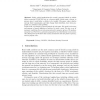Free Online Productivity Tools
i2Speak
i2Symbol
i2OCR
iTex2Img
iWeb2Print
iWeb2Shot
i2Type
iPdf2Split
iPdf2Merge
i2Bopomofo
i2Arabic
i2Style
i2Image
i2PDF
iLatex2Rtf
Sci2ools
106
Voted
ESORICS
2010
Springer
2010
Springer
Formal Analysis of Privacy for Vehicular Mix-Zones
Safety critical applications for recently proposed vehicle to vehicle ad-hoc networks (VANETs) rely on a beacon signal, which poses a threat to privacy since it could allow a vehicle to be tracked. Mix-zones, where vehicles encrypt their transmissions and then change their identifiers, have been proposed as a solution to this problem. In this work, we describe a formal analysis of mix-zones. We model a mix-zone and propose a formal definition of privacy for such a zone. We give a set of necessary conditions for any mix-zone protocol to preserve privacy. We analyse, using the tool ProVerif, a particular proposal for key distribution in mix-zones, the CMIX protocol. We show that in many scenarios it does not preserve privacy, and we propose a fix.
| Added | 09 Nov 2010 |
| Updated | 09 Nov 2010 |
| Type | Conference |
| Year | 2010 |
| Where | ESORICS |
| Authors | Morten Dahl, Stéphanie Delaune, Graham Steel |
Comments (0)

